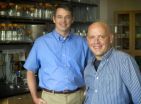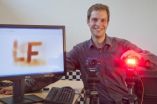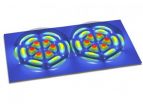(Press-News.org) Laboratory for the Spectroscopy of Planetary Atmospheres of Moscow Institute of Physics and Technology has come up with a high-resolution meter to gauge the concentration of gases in the atmosphere with unparalleled precision. The infrared spectrum radiometer is described in an article recently published in the journal Optics Express.
The paper, authored by Alexander Rodin, Artem Klimchuk, Alexander Nadezhdinsky, Dmitry Churbanov and Maxim Spiridonov, says that the new spectrum radiometer is 100 times more precise than the best available near-infrared spectrometers, and 10 times more accurate than a meter created on a similar principle recently described by NASA's Goddard Center.
Tracking down carbon dioxide, methane and other gases with simultaneous determination of their concentrations at different altitudes is necessary, in particular, for research into global warming. The vast majority of scientists do not doubt the correlation between growing temperatures on the planet and the greenhouse effect, but so far it has been impossible to positively predict future changes in global warming. A current lack of data on the distribution of greenhouse gases also compromises the forecasting and, consequently, the development of appropriate response measures. This is because in order to create a dense network of monitoring stations, many large, sophisticated and expensive spectrometers are needed.
The meter created by the Russian scientists is distinctive not only for its very high resolution, but also for its easy maintenance. The authors of the paper stress that their meter is far less susceptible to external disturbances compared with existing analogues. Its performance depends to a lesser extent on vibration, humidity and exposure to both low and high temperatures.
Alexander Rodin explained that the meter uses the heterodyne principle, known for over 100 years. The essence of the method could be best described as follows: a received signal is added to a reference signal to form an intermediate frequency signal. Generally, it does not matter whether it's a radio wave or sunlight passing through the atmosphere, as is the case in the new meter.
The converted signal is much easier to process, namely to amplify and to filter. Moreover, when the frequency of the reference signal is sufficiently stable, extremely high sensitivity can be achieved. The only problem is that a signal of very high frequency, whether it is infrared or optical, is not so easy to add to the reference source – it must be very stable and at the same time emit radiation of high intensity.
The first heterodyne radios, operating at megahertz frequencies, were created in the early 20th century, becoming mass-produced toward the end of the Second World War; while in the terahertz sphere heterodyne devices appeared only recently. For near-infrared radiation, whose frequency is a few hundred times greater, the task of combining the signals appeared to be compounded by a number of technical difficulties.
Calculations showed that a more "touchy" device is needed for a heterodyne signal in the near infrared radiation spectrum. Even a shift of a few hundredths of a wavelength (i.e. a couple of dozen nanometers) could be critical, but eventually the researchers from MIPT and their colleagues from the Moscow-based General Physics Institute managed to create a heterodyne near-infrared detector, in which a key role was played by laser stabilization.
They used an optical system that directs a laser beam to two different points, one of them a special module for mixing it with sunlight passed through the atmosphere (i.e. the analyzed signal) and the other a cell with a pure sample of the gas to be identified. Since the gas absorbs electromagnetic waves at a specific frequency, the brightness of the radiation going through the cell indicates how far the laser has deviated from the reference frequency. And this, in turn, makes it possible to adjust the frequency of the optical oscillator, i.e. laser (the word laser is an acronym of "light amplification by stimulated emission of radiation").
New spectrum radiometers may be used at both stationary and mobile stations monitoring the atmosphere, according to the official site of the IVOLGA project, which is another abbreviation translated from Russian as "infrared heterodyne fiber analyzer."
INFORMATION:
MIPT develops unique greenhouse gas meter
MIPT's Laboratory for the Spectroscopy of Planetary Atmospheres has come up with a high-resolution meter to gauge the concentration of gases in the atmosphere with unparalleled precision
2014-06-17
ELSE PRESS RELEASES FROM THIS DATE:
In the quest for safer treatment for systemic lupus erythematosus
2014-06-17
This news release is available in Spanish.
Systemic lupus erythematosus (SLE) is a chronic autoimmune disease. It can affect various organs, in particular, the skin, joints and kidneys although it displays great variability in extent and seriousness depending on the patient. Approximately nine out of every ten patients are female and it appears in one woman in every thousand.
As Dr Guillermo Ruiz-Irastorza, head of the Autoimmune Disease Research Unit of the Hospital Universitario Cruces, explained, traditionally lupus has been treated mostly with glucocorticoids ...
Genetics of sex -- beyond just birds and bees
2014-06-17
BETHESDA, MD – June 17, 2014 – Sex is everywhere in nature. Whether it's a male bird singing to mark his territory or a tiny yeast cell secreting chemicals to attract the opposite mating type, sex has profoundly shaped the appearance, behavior and evolution of many organisms. The genetic and evolutionary forces underlying sex differences and sex determination are crucial for understanding much of the natural world, including human biology.
In recognition of the importance of these topics, the Genetics Society of America journals GENETICS and G3: Genes|Genomes|Genetics ...
The genes behind immunity
2014-06-17
BETHESDA, MD – June 17, 2014 – Immunity is what stops you dying from a common cold or a tiny pinprick. Differences in resistance or tolerance to disease influence who catches the bug that's going around the office, or which species succumb to the deadly fungus devastating frogs around the world. But immunity involves more than just the immune cells that recognize and hunt down pathogens. It is influenced by the host's health, physiology, behavior, and environment. And underlying all these processes and their intricate interactions are the genes that govern their function.
This ...
UT Arlington scientists suggest 'Fragile Y Hypothesis' to explain chromosome loss
2014-06-17
A UT Arlington research team says their study of genetic information from more than 4,000 beetle species has yielded a new theory about why some species lose their Y chromosome and others, such as humans, hang on to it.
They call it the "fragile Y hypothesis."
The biologists' idea is that the fate of the Y chromosome is heavily influenced by how meiosis, or the production of sperm, works in an organism. They believe the size of an area where X and Y genetic information mingle or recombine can serve as a strong clue that a species is at risk of losing the Y chromosome ...
Self-motivated participation in learning activities increases the well-being of adults
2014-06-17
Non-vocational adult education drawing on a person's own motivation comes with a variety of benefits that are also reflected on the person's close friends, family and work. Studying boosts self-confidence and well-being, and expands social networks. Furthermore, motivation to pursue other studies also increases. Thanks to participation in adult education, tolerance towards and confidence in other people grows, and adult learners pay increasing attention to their health. Parents are better able to support the studying of their school-aged children.
All of the above are ...
With light echoes, the invisible becomes visible
2014-06-17
Scientists at the University of Bonn and the University of British Columbia (Vancouver, Canada) have developed a novel camera system which can see around the corner without using a mirror. Using diffusely reflected light, it reconstructs the shape of objects outside of the field of view. The researchers will be reporting their results at the international Conference for Computer Vision and Pattern Recognition (CVPR) from June 24-27 in Columbus (Ohio, USA).
A laser shines on the wall; a camera watches the scene. Nothing more than white ingrain wallpaper with a bright spot ...
Three parents and a baby
2014-06-17
Mitochondria are cell organelles located within animal and human cells. They produce energy for the organism, possess their own genetic material - mitochondrial DNA (mtDNA) - and are transmitted exclusively by the mother. Depending on their activity and tasks, different numbers of mitochondria are present in a cell - usually a few hundred to a thousand per body cell.
Inherited mitochondrial disorders or so-called mitochondropathies occur in about one of 10,000 humans throughout the world. Diseases such as diabetes, stroke, cardiac defects, epilepsy, or muscle weakness ...
Chemical pollution of European waters is stronger than anticipated
2014-06-17
This news release is available in German.
Substantial improvements in freshwater quality by 2015 have been a declared objective of the EU member states, manifesting itself by the requirements of the Water Framework Directive (WFD). A recent study conducted by the Institute for Environmental Sciences Landau together with the Helmholtz Centre for Environmental Research (UFZ) and fellow scientists from France (University of Lorraine and EDF) and Switzerland (Swiss Federal Institute of Aquatic Science and Technology - EAWAG) shows that this target is unlikely to be ...
Social inequality intensifies amongst low-scoring pupils
2014-06-17
Children's marks at school influence the likelihood of them abandoning their studies, but the effect varies according to their social background: among students with poor marks, those from a higher social class have more opportunities to raise their marks than children of low-skilled workers. This is according to a study carried out by researchers from the National University of Distance Learning (UNED) and the European University Institute.
"The study deals with dissociating the effect of the marks (considered the 'primary source' of educational results) from other processes ...
Strange physics turns off laser
2014-06-17
Inspired by anomalies that arise in certain mathematical equations, researchers have demonstrated a laser system that paradoxically turns off when more power is added rather than becoming continuously brighter.
The finding by a team of researchers at Vienna University of Technology and Princeton University, could lead to new ways to manipulate the interaction of electronics and light, an important tool in modern communications networks and high-speed information processing.
The researchers published their results June 13 in the journal Nature Communications (Ref. 1).
Their ...
LAST 30 PRESS RELEASES:
Sports injuries sustained during your period might be more severe
World's first successful 2 Tbit/s free-space optical communication using small optical terminals mountable on satellites and HAPS
Can intimate relationships affect your heart? New study says ‘yes’
Scalable and healable gradient textiles for multi‑scenario radiative cooling via bicomponent blow spinning
Research shows informed traders never let a good climate crisis go to waste
Intelligent XGBoost framework enhances asphalt pavement skid resistance assessment
Dual-function biomaterials for postoperative osteosarcoma: Tumor suppression and bone regeneration
New framework reveals where transport emissions concentrate in Singapore
NTP-enhanced lattice oxygen activation in Ce-Co catalysts for low-temperature soot combustion
Synergistic interface engineering in Cu-Zn-Ce catalysts for efficient CO2 hydrogenation to methanol
COVID-19 leaves a lasting mark on the human brain
Scientists use ultrasound to soften and treat cancer tumors without damaging healthy tissue
Community swimming program for Black youth boosts skills, sense of belonging, study finds
Specific depressive symptoms in midlife linked to increased dementia risk
An ‘illuminating’ design sheds light on cholesterol
Who is more likely to get long COVID?
Study showcases resilience and rapid growth of “living rocks”
Naval Research Lab diver earns Office of Naval Research 2025 Sailor of the Year
New Mayo-led study establishes practical definition for rapidly progressive dementia
Fossil fuel industry’s “climate false solutions” reinforce its power and aggravate environmental injustice
Researchers reveal bias in a widely used measure of algorithm performance
Alcohol causes cancer. A study from IOCB Prague confirms damage to DNA and shows how cells defend against it
Hidden viruses in wastewater treatment may shape public health risks, study finds
Unlock the power of nature: how biomass can transform climate mitigation
Biochar reshapes hidden soil microbes that capture carbon dioxide in farmland
Reducing saturated fat intake shows mortality benefit, but only in high-risk individuals
Manta rays create mobile ecosystems, study finds
Study: Mixed results in using lipoic acid to treat progressive multiple sclerosis
Norbert Holtkamp appointed director of Fermi National Accelerator Laboratory
New agentic AI platform accelerates advanced optics design
[Press-News.org] MIPT develops unique greenhouse gas meterMIPT's Laboratory for the Spectroscopy of Planetary Atmospheres has come up with a high-resolution meter to gauge the concentration of gases in the atmosphere with unparalleled precision






